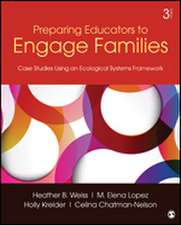Collaboration in the New Life Sciences
Editat de John N. Parker, Niki Vermeulen, Bart Pendersen Limba Engleză Paperback – 16 iun 2017
| Toate formatele și edițiile | Preț | Express |
|---|---|---|
| Paperback (1) | 449.41 lei 6-8 săpt. | |
| Taylor & Francis – 16 iun 2017 | 449.41 lei 6-8 săpt. | |
| Hardback (1) | 1061.81 lei 6-8 săpt. | |
| Taylor & Francis – 28 sep 2010 | 1061.81 lei 6-8 săpt. |
Preț: 449.41 lei
Nou
Puncte Express: 674
Preț estimativ în valută:
85.99€ • 89.79$ • 71.01£
85.99€ • 89.79$ • 71.01£
Carte tipărită la comandă
Livrare economică 15-29 aprilie
Preluare comenzi: 021 569.72.76
Specificații
ISBN-13: 9781138306486
ISBN-10: 1138306487
Pagini: 286
Dimensiuni: 156 x 234 mm
Greutate: 0.45 kg
Ediția:1
Editura: Taylor & Francis
Colecția Routledge
Locul publicării:Oxford, United Kingdom
ISBN-10: 1138306487
Pagini: 286
Dimensiuni: 156 x 234 mm
Greutate: 0.45 kg
Ediția:1
Editura: Taylor & Francis
Colecția Routledge
Locul publicării:Oxford, United Kingdom
Notă biografică
Bart Penders is an assistant professor in Biomedine and Society in the Department of Health, Ethics and Society at Maastricht University, the Netherlands. He is co-editor of Collaboration Across Health Research and Medical Care. Niki Vermeulen is Lecturer in the History and Sociology of Science at the University of Edinburgh, UK, and co-editor of Collaboration Across Health Research and Medical Care and Bio-Objects: Life in the 21st Century. John N. Parker is an Honors Faculty Fellow at Barrett, The Honors College at Arizona State University. He is co-editor of Collaboration Across Health Research and Medical Care.
Recenzii
'A fascinating selection of in-depth studies: varied forms of collaboration make for new big science, and the new life sciences call for new forms of collaboration. This volume combines scholarly originality and insight with relevance for policy makers and the public.' Wiebe E. Bijker, Maastricht University, The Netherlands 'Collaboration in the New Life Sciences could hardly be timelier. Just at the time that researchers have begun to create new collaborative media and dynamics comes this excellent volume, lifting the curtain, and showing us a good measure of the wizardry. The chapters are diverse, are well and richly grounded in emergent theory from Science and Technology Studies and, at the same time, show intimate familiarity with the scientific content that is their focus. Readable and accessible, this book will inform both the social theorist seeking meaning from new collaborative forms, as well as life scientists wishing to reflect more deeply on work routines and their social meaning.' Barry Bozeman, University of Georgia, USA 'The publication of this book, is certainly timely, and the case-studies which it provides on collaborative practices from Asia, Europe and the USA, give insights into scientific practices in these countries. In many ways, the style of writing throughout this book seems to convey that the authors reflected deeply on the socially constructed elements of ’received wisdom’ which prevail in science and policy-making. The book would have some appeal, not only to ecologists and social scientists who are interested in knowledge production. Some practical advice is given on how collaboration works in practice, which could have relevance to scientists in other disciplines and for policy-making. ... Overall, this book makes an important contribution to the literature, laying emphasis on cultural features of collaboration. However, perhaps its greatest achievement is the amount of ideas and questions that the various chapters raise
Cuprins
Part I Collaboration Arises; Chapter 1 Collecting Collaborations: Understanding Life Together, Niki Vermeulen, Bart Penders; Chapter 2 Organising the Field: Collaboration in the History of Ecology and Environmental Science, Stephen Bocking; Chapter 3 Multidisciplinary Collaborations in Toxicology and Paleo-ecology: Equal Means to Different Ends, Laurens K. Hessels, Stefan de Jong, Harro van Lente; Part II Collaboration in Ecology and the Environment; Chapter 4 Two Approaches to Big Science: An Analysis of LTER and NEON, Ann Zimmerman, Bonnie A. Nardi; Chapter 5 Integrating the Social into the Ecological: Organisational and Research Group Challenges, John N. Parker; Chapter 6 Infrastructuring Ecology: Challenges in Achieving Data Sharing, karen S. Baker, Florence Millerand; Chapter 7 Customisation of Transdisciplinary Collaboration in the Integrated Management of Contaminated Sites, Vivien Behrens, Matthias Gross; Chapter 8 A Data Bias in Interdisciplinary Cooperation in the Sciences: Ecology in Climate Change Research, Chunglin Kwa, René Rector; Part III Collaboration in the Molecular Life Sciences; Chapter 9 Matchmaking Mechanisms: Collaborative Arrangements in Proteomics and Bioinformatics, Jamie Lewis; Chapter 10 Systems Biology, Interdisciplinarity and Disciplinary Identity, Jane Calvert; Chapter 11 The Rice Sequence Collaborations: Globalisation, Innovation Networks and the Burgeoning Life Sciences in Asia, Lyndal Halliday; Part IV Collaboration in the New Life Sciences Revisited; Chapter 12 Collaborationism, Wesley Shrum;
Descriere
With an international team of experts presenting case studies and analyses drawn from the US, UK, Asia and Europe, Collaboration in the New Life Sciences offers a critical examination of the causes and consequences of changing patterns of scientific collaboration in the life sciences. It will appeal to scholars and students of science and technology studies, as well as those interested in science, social policy, and the sociology of work and organizations.







